
The Celastraceae are a family of 98 genera and 1,350 species of herbs, vines, shrubs and small trees, belonging to the order Celastrales. The great majority of the genera are tropical, with only Celastrus, Euonymus and Maytenus widespread in temperate climates, and Parnassia (bog-stars) found in alpine and arctic climates.

Myoporum is a genus of flowering plants in the figwort family, Scrophulariaceae. There are 30 species in the genus, eighteen of which are endemic to Australia although others are endemic to Pacific Islands, including New Zealand, and one is endemic to two Indian Ocean islands. They are shrubs or small trees with leaves that are arranged alternately and have white, occasionally pink flowers and a fruit that is a drupe.

Loasaceae is a family of 15–20 genera and about 200–260 species of flowering plants in the order Cornales, native to the Americas and Africa. Members of the family include annual, biennial and perennial herbaceous plants, and a few shrubs and small trees. Members of the subfamily Loasoideae are known to exhibit rapid thigmonastic stamen movement when pollinators are present.
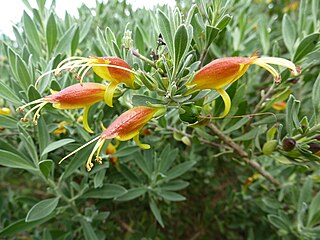
Eremophila glabra, commonly known as tar bush, is a plant in the figwort family, Scrophulariaceae and is endemic to Australia. It is sometimes a low, ground-hugging and sometimes an erect shrub. The leaves are variable in size and shape and there is a range of flower colours. In spite of its scientific name, not all forms of the plant are glabrous but most have many small, raised glands on the stems, flowers and leaves.
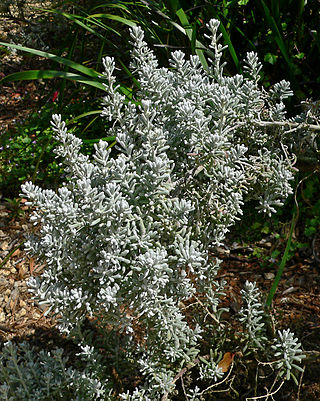
Maireana is a genus of around 57 species of perennial shrubs and herbs in the family Amaranthaceae which are endemic to Australia. Species in this genus were formerly classified within the genus Kochia. The genus was described in 1840 by the botanist, Moquin-Tandon and named to honour Joseph François Maire (1780-1867), an amateur botanist who befriended him during the author's first visit to Paris in 1834.
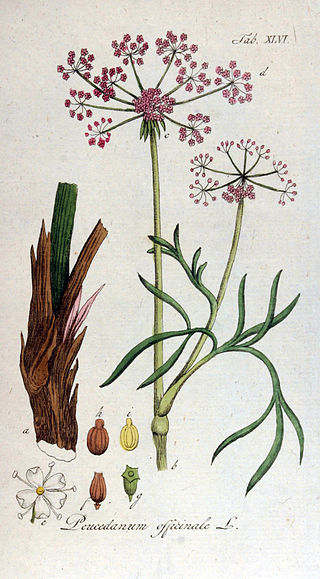
Peucedanum is a genus of flowering plant in the carrot family, Apiaceae. Peucedanum boasts a global presence with diverse spread of morphological features. Peucedanum species are characterized by dorsally compressed mericarps, slightly prominent dorsal ribs, narrowly winged lateral ribs, and a broad commissure. However, the vast diversity of morphology, fruit forms, and phytochemical production makes classifying species in the Peucedanum challenging. Historically relevant in traditional medicine, Peucedanum's taxonomic complexity arises from its extensive diversity.
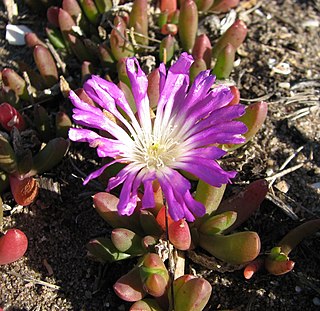
Disphyma is a genus of flowering plants in the family Aizoaceae that are native to New Zealand, Australia and southern Africa. Plants in this genus are prostrate, annual or short-lived perennial shrubs with succulent leaves and daisy-like flowers arranged singly on the ends of shoots with petal-like staminodes, many stamens and usually five styles.
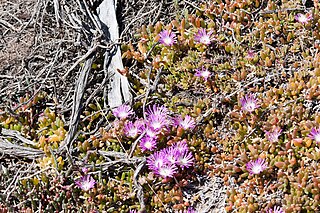
Disphyma crassifolium, commonly known as round-leaved pigface or salty fingers is a species of flowering plant in the family Aizoaceae native to Australia and the Cape Provinces of South Africa. It is a prostrate, succulent annual shrub or short-lived perennial plant with stems up to 2 m long, leaves that are three-sided in cross-section with a rounded lower angle, and purple daisy-like flowers with staminodes up to 30 mm (1.2 in) long.

Disphyma crassifolium subsp. clavellatum is the subspecies of Disphyma crassifolium that occurs in Australia and New Zealand. It is sometimes known by the common name rounded noon-flower

In botany, succulent plants, also known as succulents, are plants with parts that are thickened, fleshy, and engorged, usually to retain water in arid climates or soil conditions. The word succulent comes from the Latin word sucus, meaning "juice" or "sap".

Sclerolaena is a genus of annuals or short-lived perennials in the family Chenopodiaceae, which are included in Amaranthaceae according to the APG classification.
Robert James (Bob) Chinnock is a New Zealand-born Australian botanist who worked at the State Herbarium of South Australia as a senior biologist. He retired in 2008 but still works as an honorary research associate.

Gunniopsis is a genus of flowering plants in the iceplant family, Aizoaceae. These plants are found in areas of inland Australia.
Ancistrachne maidenii is a grass endemic to New South Wales.
Carinavalva is a genus of flowering plants belonging to the family Brassicaceae.
Embadium is a genus of flowering plants belonging to the family Boraginaceae.
Grammosolen is a genus of flowering plants belonging to the family Solanaceae.

Maireana pentagona, the hairy bluebush, is a species of flowering plant in the family Amaranthaceae, native to Australia. A prostrate or decumbent perennial, it typically grows in heavy soils.
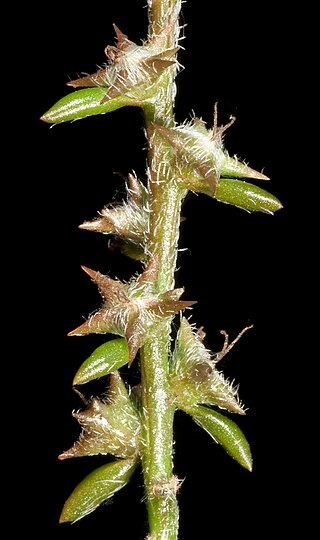
Sclerolaena parviflora is a species of flowering plant in the family Amaranthaceae, found in every mainland state and territory of Australia. It was first described in 1923 by Robert Henry Anderson as Bassia parviflora, but was transferred to the genus, Sclerolaena in 1978 by Andrew John Scott.
Maireana cheelii, common name - chariot wheels, is a species of flowering plant in the family Amaranthaceae, native to Victoria, New South Wales, and Queensland. It is found on seasonally wet, heavy loams and clay soils.












